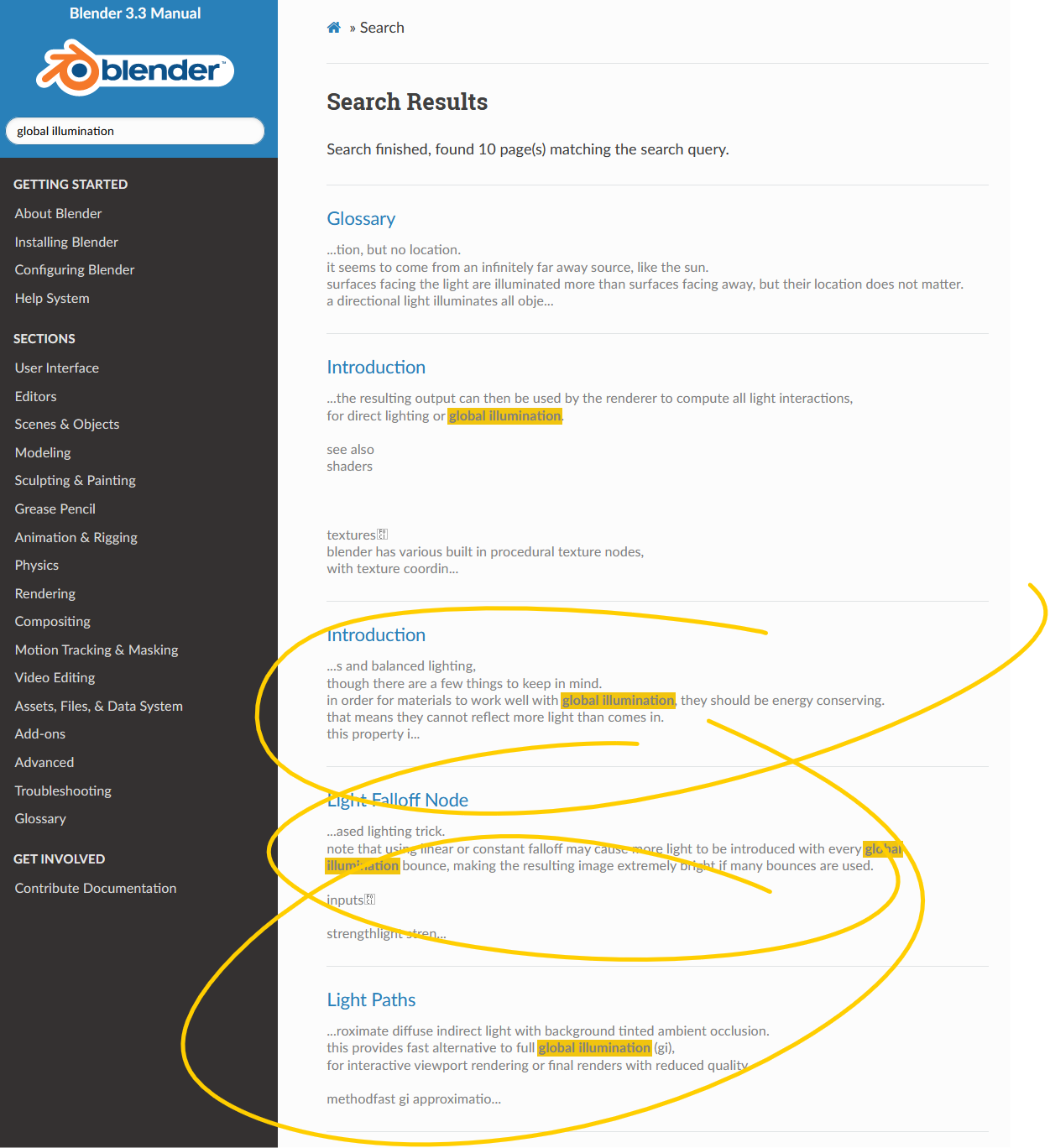Include Description in the Search Documentation?
-
Hi,
Is it possible to include the description in the search documentation?
Case in point: "Bounding Box"
It doesn't return the
GetRadmethod that outputs the actual bounding box. It does returnc4d.BaseObjectbut the unassuming wouldn't know there is such method. -
Hello @bentraje,
Thank you for reaching out to us. Could you elaborate what you mean by description in this context?
For clarification: Description has a reserved meaning in the Cinema 4D API, and I assume you are somewhat aware of that, but at least I cannot connect the dots how you mean that.
All
C4DAtominstances have a description (some are empty though). A description is primarily represented by*.res, *.hand*.strfiles on disk, e.g., this is the resource file for the cube object.CONTAINER Ocube { NAME Ocube; INCLUDE Obase; GROUP ID_OBJECTPROPERTIES { GROUP { VECTOR PRIM_CUBE_LEN { MIN 0 0 0; UNIT METER; CUSTOMGUI SUBDESCRIPTION; } LONG PRIM_CUBE_SUBX { MIN 1; MAX 1000; CUSTOMGUI LONGSLIDER; STEP 1; MINSLIDER 1; MAXSLIDER 20; } LONG PRIM_CUBE_SUBY { MIN 1; MAX 1000; CUSTOMGUI LONGSLIDER; STEP 1; MINSLIDER 1; MAXSLIDER 20; } LONG PRIM_CUBE_SUBZ { MIN 1; MAX 1000; CUSTOMGUI LONGSLIDER; STEP 1; MINSLIDER 1; MAXSLIDER 20; } SEPARATOR { } BOOL PRIM_CUBE_SEP { } BOOL PRIM_CUBE_DOFILLET { } REAL PRIM_CUBE_FRAD { PARENTID PRIM_CUBE_DOFILLET; MIN 0; UNIT METER; CUSTOMGUI REALSLIDER; STEP 1; MINSLIDER 0; MAXSLIDER 20; } LONG PRIM_CUBE_SUBF { PARENTID PRIM_CUBE_DOFILLET; MIN 1; MAX 1000; CUSTOMGUI LONGSLIDER; STEP 1; MINSLIDER 1; MAXSLIDER 10; } } } }In the Python API, descriptions are represented by c4d.Description instances, which are accessible for every atom via
C4DAtom.GetDescription. Such description then contains the content of the files mentioned above. In the Python documentation descriptions are documented, you can find theOcubedescription for example here.BaseObject.GetRad()is however not part of descriptions, as this information is simply not stored there. Dcoumented is the base description for all objects,Obasebut this just contains all the entry points for accessing the transform(s) of an object among other things.So, could you please clarify what you mean? I am not saying that this might not be a reasonable request, I am just struggling a bit with what you want to be done here.
But the bounding box radius of an object cannot be found in its description, and while everything is possible with enough dedication, I do not see the direct benfit of exposing this value as a description parameter.
Cheers,
Ferdinand -
No worries. My fault for not specifying.
Here's what I meant by "description" in a layman way. huehueGetRadhas a description of "This is the bounding box radius of the object". But it doesn't get return as a search result of "bounding box" in search documentation.Of course, it's not necessarily a deal breaker since if you search "bounding box" in the forum and you'll see
GetRadgets mentioned.
But it makes a "secondary" documentation compared to the forum.There's several cases like that where it should be a simple search in the documentation but it gets tricky.

-
Hello @bentraje,
ah, okay, I get what you mean, you want us to spice up the search index with related concepts and synonyms, so that you can search for "bounding box" and it will spit out these two methods or that you search for "geometry" and it will spit out
c4d.PolygonObjectfor example.Yeah, we have already talked about this internally and more sematic relations to things would be indeed helpful, both in C++ and Python. And Sphinx, i.e., our Python platform is better with this than Doxygen, our C++ platform. When you search for
bounding box radiusit will actually spit outc4d.BaseObjectas the third hit (Doxygen would not do that).It is possible to spice up the indices of Sphinx manually, but apart from technical problems related to Sphinx which are all more or less solvable with enough time, constructing search engine indices is no trivial task. You can of course ingest everything which is not tied to the ground into the index, but this will have the result of bloated search results as already to be experienced with Sphinx and the large amounts of junk its full-text search indexing produces.
To have a high recall and precision in search results, a high DCG - or less technical: have all and only the relevant stuff in search results - you usually must get much more sophisticated with your data than either Sphinx or Doxygen are. From an external perspective this might seem trivial - just index this, just index that - but our document space is simply too large to do this by hand directly on a database/SE level. To solve this truly we would have to migrate our documentation data to more complex data structures which make this manual indexing a. easier and b. partially automated.
The naive approach, simply tokenizing all text, then removing stop words, and then ingesting them in all contexts will yield very bloated search results. So, all I can say here is: We are aware and we also want a better search, but it is currently undecided which technical route we will take.
Cheers,
Ferdinand -
Uhm. It's not as complicated as that.
I mean it is complicated per se but there are already existing solutions.
Check "Sphinx Search Extension". There are several.
Pip install it and just insert it into theconf.pyfile.Also, it's not really as spicing it up per se.
I mean it is but not really.It's just adding a sub paragraph section.
The maxon redshift documentation is already doing it.
And even if you are using sphinx implementation, it's also existing.
Blender documentation is built using sphinx.